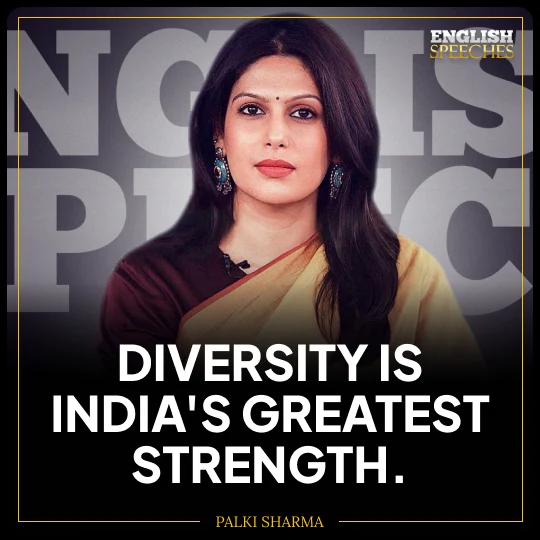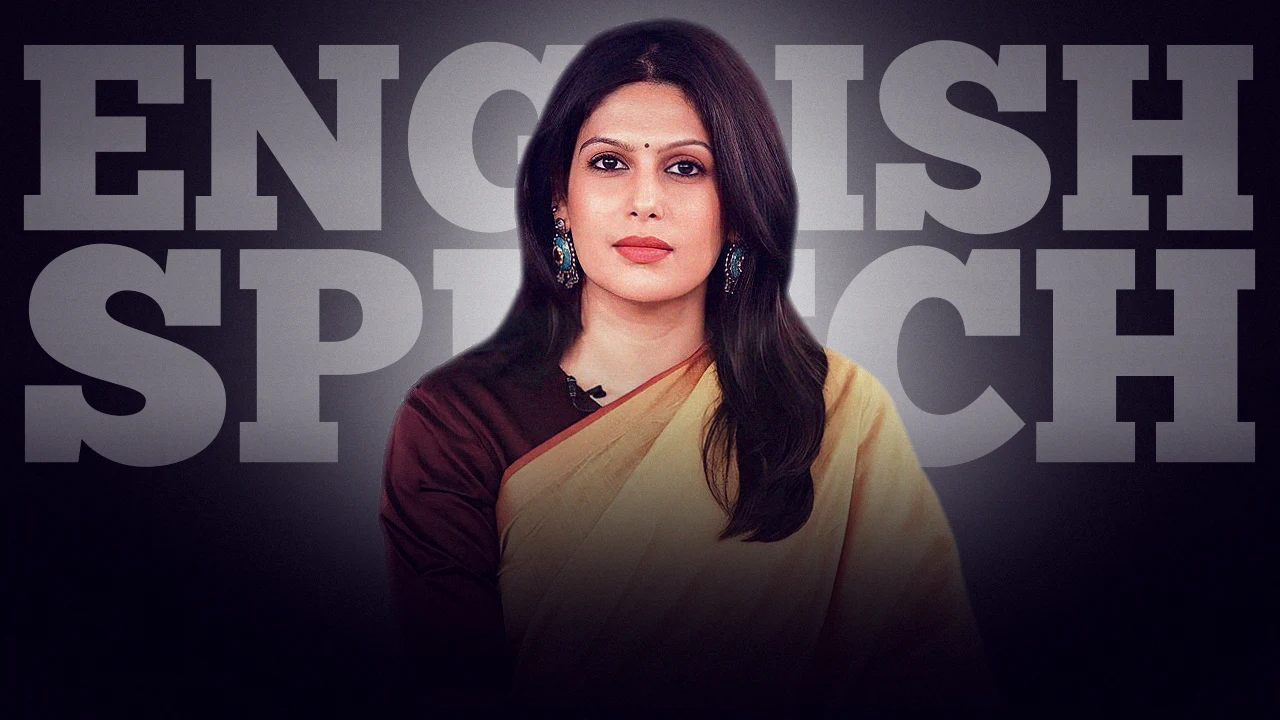Learn English with Palki Sharma. Join Palki Sharma as she delves into the current state and future direction of India under Modi’s leadership. In this compelling speech, Sharma discusses the remarkable progress in financial inclusion, digital penetration, and global diplomacy. She highlights India’s increased confidence on the world stage and examines the challenges and opportunities that lie ahead. Don’t miss this insightful analysis of Modi’s India and its path forward.
India stands at a crossroads, with Prime Minister Narendra Modi’s leadership catapulting the nation onto the global stage since 2014. In a recent speech, renowned journalist Palki Sharma explored India’s trajectory under Modi, highlighting significant achievements in economic growth, financial inclusion, and digital advancement. However, she also acknowledged the criticisms and challenges faced by the administration. As India continues to navigate its path, it is crucial to understand the key lessons and themes from Sharma’s insightful analysis.
A Vision for Growth and Inclusion
During her speech, Palki Sharma painted a vivid picture of India’s progress. She recounted a personal experience that encapsulates the nation’s rapid development: witnessing roadside vendors in Delhi utilizing QR codes for digital payments. This simple yet profound observation highlights three critical aspects of India’s growth under Modi’s leadership:
- Financial Inclusion: The widespread adoption of digital payments reflects the significant strides India has made in financial inclusion. With mobile banking becoming accessible to millions, even street vendors are now part of the formal economy.
- Digital Penetration: Sharma noted that internet penetration has surged from 15% to 48% in just nine years, empowering citizens with unprecedented access to information and services.
- Infrastructure Expansion: The increase in airport traffic and infrastructure development signifies India’s growing connectivity and its aspiration to bridge the urban-rural divide.
Sharma emphasized how these advancements are reshaping India’s identity, transforming it into a confident and resilient nation poised for global leadership.
Key Lessons and Themes
Palki Sharma’s speech highlighted several key lessons and themes that resonate beyond India’s borders:
- The Power of Empowerment: India’s approach to growth is not merely about economic indicators; it is about empowering individuals and communities. By providing access to financial services and digital tools, India is enabling its citizens to participate actively in the nation’s progress.
- Balancing Tradition and Modernity: India’s journey underscores the importance of balancing tradition with modernity. While embracing technological advancements, the country remains rooted in its cultural heritage, leveraging its diversity as a strength.
- Navigating Global Diplomacy: Sharma lauded India’s diplomatic efforts, portraying the nation as a consensus builder rather than a troublemaker. India’s ability to maintain strong relations with both the West and the global South exemplifies its nuanced approach to international affairs.
- Addressing Criticisms: Despite the achievements, Sharma acknowledged the criticisms faced by Modi’s administration, particularly concerning the agricultural sector, religious tensions, and challenges in the health and education sectors. These issues serve as reminders that progress must be inclusive and equitable.
In reflecting on India’s journey, it is essential to honor the individuals who have contributed to the nation’s growth and resilience. The stories of everyday Indians embracing digital tools, overcoming challenges, and striving for a better future exemplify the enduring strength and spirit of the nation. As India continues to evolve, it must address its shortcomings while celebrating the achievements that inspire hope and progress.
Donwload available for Premium Subscribers
PDF Full Transcript
Explore every word with our concise PDF transcripts.
Audio Version
Immerse in speeches with clear, downloadable audios.
English Lesson
Enhance English skills with interactive speech lessons.
⚬ Free 30-day trial

”Diversity is India's greatest strength.
Transcript
Thank you, Mister President. Namaskar and good evening to all of you. We’re debating India’s path tonight, and I could wrap my argument in one sentence borrowed from the White House. Go to New Delhi and see it for yourself. But I’ve been given more time than that, so I will tell you what I see. Earlier this week, I was on my way to the Delhi airport. There was a lot of traffic. At one point, the car stopped. On the roadside, I saw two vendors. One was selling fruit; the other was selling coconut water. What caught my attention was not what they were selling but how they were selling it. Both had a QR code prominently displayed, and every single customer walked up to them, scanned this QR code, and paid for their purchase, every single one of them. To me, this is a picture of today’s India. It shows three developments, three of the many developments I shall list out tonight.
Number one is financial inclusion. Both the vendors had a bank account linked to their mobile phone. Number two is Internet or mobile penetration, what we call digital India. It was 15 percent nine years back. It’s 48 percent today. And number three is the airport traffic. It just keeps swelling, even though we are at the receiving end. We see what it shows, from 67 million nine years back to almost double now. To me, these things signify the path that India is on.
The previous speakers have defined the motion well, but in case the evening drinks have kicked in, let me repeat. This house believes Modi’s India is on the right path. And how do you determine if the path is right or wrong? You look at numbers, data, surveys, and reports. I shall refer to all of these as I make my arguments. But I also want to dwell on something that’s more personal, more important, I think, yet unquantifiable. I’m talking about the experience of living in today’s India. I have lived in many Indias. The weary India, where exciting policies and positions were abandoned. The self-doubting India, where decisions were taken based on global opinion. And today, a more confident India, where the world comes for leadership and inspiration. You cannot put a premium on that. Indians are more prosperous at home, and hence more confident abroad. Let me also tell you what I saw at the airport here in London, at the immigration counter. I saw Indians proudly flaunting their passports, none of the fidgeting or self-doubt of the last century. And if I may add, the immigration officer almost looked impressed. She was either a fan of India or just worried that she was holding up one of Rishi Sunak’s relatives. We are proud of what we share with the world: Bollywood, masala chai, yoga, cricket. India today is a soft power giant.
At the same time, India is not a timid democracy that tolerates terrorism or betrayals. When Pakistani terrorists attacked Kashmir’s Pulwama, India carried out surgical strikes on Balakot. Today’s India is not a pushover country. It’s a world power denied. Today, invasions and colonialism are part of our history, not our identity. We are shaped by years of subjugation, not defined by them. We are excited about our global responsibilities, not wary of them. This change in confidence comes from growth at home. Which brings me to the numbers. I’ll start with India’s welfare state system and how it has fared in the past decade: 110 million new gas connections, 470 million bank accounts, 220 million insurance beneficiaries. And to be fair, the welfare concept is not new to India. It’s been there for a while. What’s new is the approach. It’s not just about putting more money in the pocket; it’s about empowering people. And the result, once again, the evidence, shows in the numbers. India’s per capita income has gone from 86,000 rupees in 2014 to 172,000 rupees now. It has doubled. And a big reason for that is the falling inflation. From more than 8% nine years back to less than 6% today. And this, ladies and gentlemen, is in the middle of a global cost of living crisis.
Foreign direct investment is at its highest level. Foreign trade is at its highest level. The growth mantra is connectivity. And I don’t have to tell the British that. First thing you did in your colonies was build roads and railways. Our growth story has been about two Indias. The urban India, the bustling urban India, and a sluggish rural India. Today we are trying to connect the two. We are building more than 38 kilometers of highway every day, which is 50% more than what it was seven years ago. The number of airports has doubled since 2014. The total capacity at seaports has doubled. This connectivity is what is driving India forward.
You mentioned GST. Our constitution calls India a union of all states, which is a great tribute to our diversity. But it also meant 28 different state economies, different taxes, and different trade practices. This government tried to unify it to create a single Indian market. It took time. But the result is this today. Tax collection is at its highest ever. The number of taxpayers has doubled since 2017. I have a lot of data I could go on, but you get the drift.
So now I’m going to talk about India’s global position. Because your path is also about your role in the world. Are you a troublemaker or a consensus builder? I think there is no doubt as to where India stands. India is a member of the Quad and the SCO. India is invited to the G7 but is also a member of the BRICS. India rubs shoulders with the West but also leads the global South. Which other country can claim to juggle these roles? And how does India do it? Because we are not trying to play an outsized role in the world. We are trying to play the right role. In the Russia-Ukraine war, India has not taken sides. And I know it confuses a lot of people here, but back home, the thinking is very clear. It is not in our national interest to pick sides and make things worse. India has excellent relations with Russia and the West, and we want to preserve that. It’s like when your two good friends fight. Do you pick sides and make things worse? Or do you try to talk sense to them and bridge the divide? I know what a good friend would do. I see what India is doing. India has always tried to be a part of the solution, not the problem. Look at our neighborhood policy. When Sri Lanka was sinking, India provided assistance worth $4 billion. No strings attached, no grudges held for Colombo’s proximity with China. A lot of people say that India is losing control of South Asia. I say South Asia was never India’s to control. New Delhi is building relations based on mutual respect and equality, and the results show beyond government interactions. Countries like Nepal and Bhutan are using India’s online payment systems. Students from the neighborhood come to India for training, grants, and scholarships. This government has aced what we call Buddhist diplomacy. It is leveraging India’s position as a cradle of Buddhism. All these initiatives have made India popular. The world stands with us against Chinese expansionism. The global South looks up to us for leadership. The global North looks up to us for partnership. I think that’s the hallmark of great diplomacy and statecraft, when you’re loved and respected in all quarters, more importantly, when you’re trusted in all quarters.
India repaid that trust during the COVID-19 pandemic, when the world forgot about morals and globalization. India sent 24 crore vaccines to 100 countries. And you saw the result of that in Papua New Guinea. When Prime Minister Modi landed there, their Prime Minister touched his feet. This was not a personal gesture to a leader. This was a vote of thanks to the entire country.
Let’s talk about domestic affairs. Kashmir was brought up. This government abrogated Article 370. Today, Kashmir’s economy is doing much better. 1.8 crore tourists visited the valley in the last year. That’s the highest ever in Indian history, 1.8 crore. Kashmir is getting its first ever foreign direct investment, and that too from a company in the UAE. But since this is Kashmir, let’s not limit ourselves to finances. Let’s talk about security. Terror attacks in the valley have almost halved in the last few years. The numbers are staring in your face. Security is better, economy is better, Kashmir is better. Plus, we have corrected a historical wrong imposed on India.
Let me also address something else that was raised by the opposite side, and that is religious intolerance. It’s easy to quote anecdotal evidence and paint an entire country as intolerant. But random elements and sporadic incidents do not speak for India or its leadership or its government. Only policies do, and I’ll tell you about those policies. More Muslim students got scholarships in Modi’s first term than the previous government. I’m talking about 2 million more Muslim students. If the idea was to marginalize them, why give them more scholarships? Look at the government’s Hajj policy. Prime Minister Modi held personal talks with the Saudi regime to increase India’s Hajj quota. In 2014, it was 136,000. By 2019, it was more than 200,000. Again, if the idea was to marginalize Muslims, why increase the Hajj quota? This government abolished triple talaq. Do you call it reform or repression? Let me also tell you what a Pew study found in 2021. It runs counter to every argument that will be made here tonight. It found that 89% of all Muslims and Christians in India say they’re free to practice their religion. I’ll repeat, 89% of all surveyed Muslims and Christians, but no, let’s build on perceptions and anecdotes, not on facts. I would also point you to all the social schemes, the bank accounts, the gas connections, the insurance policies that are available to all citizens of all religions.
Does that mean India cannot do better? Absolutely not. Even one incident of marginalization is one too many, but how would you judge an entire country’s path? In fact, it struck me when I was invited to this event, why would Oxford University be interested in debating the path of Modi’s India? Because India has defied Western predictions. It’s the world’s largest democracy charting its own course. India today has shed the burden of trying to comply with Western constructs. No amount of lecturing or virtue signaling is shaking India’s confidence, and that is what unsettles critics. There are hit and run experts with no accountability who make pronouncements based on their political leanings to create an anti-India narrative. GDP growth won’t touch 5%; there was corruption in the Rafale deal; the government was snooping in opposition parties using Pegasus. All of these make for juicy headlines, and they make it look like everything is wrong in India. But when a Supreme Court investigation finds no wrongdoing, when India’s growth crosses 7%, who is questioning these experts? When an 85% Hindu majority Karnataka votes out the BJP, is the Western lauding India’s secular credentials? You see, to judge a country’s path, you have to be able to separate agenda-driven narrative from facts.
In conclusion, let me say this. For any country in the world, there is always a wrong path. Enough dictators and autocrats have shown us, but there is no single right path. Britain has its own right path; India has its own right path. As long as democracy is respected, as long as the constitution is respected, I would say to each their own. It is wrong to judge one country on the parameters of another. And that has been the beauty of India since 2014. We’ve uplifted 140 million people out of poverty. We did so while conducting free and fair elections, dozens of them. We did so while protesting, debating, and dissenting. And finally, I think the hallmark of a right direction is also public approval. Do the people think you’re on the right path? The people of India answered that question in 2019. Thank you.






